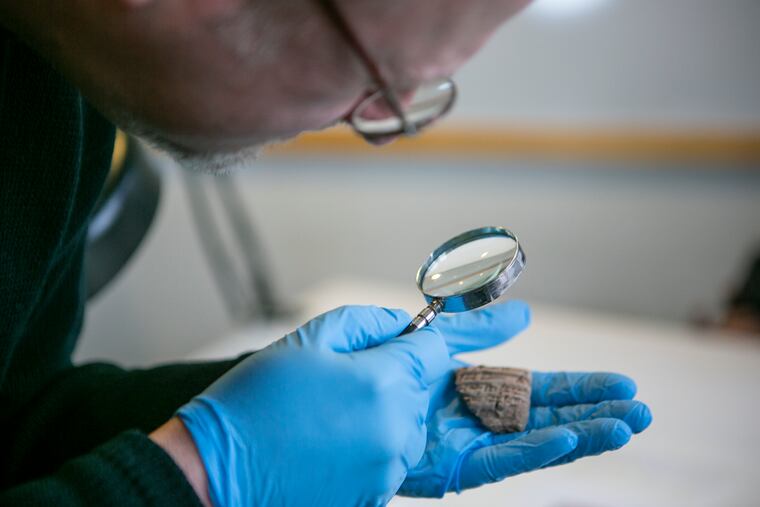Penn Museum returning fragments of tablets excavated a century ago in Iraq
About 400 fragments excavated in the 1920s and 1930s in the royal city of Ur are being returned under terms of the original agreement with Iraqi authorities.

On Wednesday, researchers and archaeologists from the University of Pennsylvania Museum will hop into a van and head to the Iraqi Embassy in Washington with several carefully packed boxes of clay tablets that left their ancient homeland following archaeological excavations nearly a century ago.
The repatriation of about 400 clay tablets, mostly fragments incised with writing, has been in the works for some time, Penn researchers said. The fragments were excavated from the ancient Mesopotamian city of Ur during expeditions involving Penn and the British Museum led by Leonard Woolley from 1922 to 1934.
All told, Penn received about 7,500 tablets and fragments from the Ur excavations.
They were transported out of Iraq to Philadelphia following excavation for study under a loan agreement with the Iraqi government. They were to be studied by Penn and then returned to their homeland. Most have already been returned to Iraq.
“Tablets that we received as part of the original 1920s agreement were studied, published [in scholarly journals], and returned at various times,” said William B. Hafford, a museum research associate. “The initial group of around 1,800 well-preserved and mostly complete tablets were published pretty quickly, as things go. They appeared ... in 1937.”
Hafford said that another batch of about 1,400 “relatively well-preserved large fragments” were published in scholarly journals about Ur in 1976. “All of those were returned in 1991,” he added.
The tablets largely record economic transactions, Hafford said, providing insight into what goods were traded, where they came from, and how items were valued relative to one another and to amounts of silver.
The fragments returned in 1991 "were taken directly to Iraq by museum personnel and would have been returned earlier but there was difficulty in getting visas to do the return in country,” Hafford said.
Cultural artifacts are no longer removed for study and research — those activities take place in the home country — and much of the Ur material is now online at ur-online.org. Officials at the Iraqi Embassy did not immediately respond to inquiries about the tablets’ return.
Now heading home
The 387 fragments being returned Wednesday “are quite small and difficult to study,” Hafford said.
Some scholars believed it might be possible to decipher and publish the contents of the remaining tablets, he said, but as time dragged on Penn decided, in consultation with Iraqi authorities, that maybe returning the tablets would be best all around.
“At this point, we realize we have had them too long and that even though they carry some information, it will take many more years for specialists to do that work,” Hafford said. "Plus, there are many in Iraq who can do that work now, and so we are returning the tablets and what information we have on them as a show of our commitment to return everything that was part of the original agreement.”
Once the batch of 387 fragments is presented to the Iraqi government at the embassy on Wednesday, Penn will retain about 3,500 fragments and small pieces in very poor condition, Hafford said.
Those small shards and fragments remaining at Penn had been found under a floor at the Ur excavation, apparently used as foundation material for house construction.
“They seemed to be put down for support,” said Hafford. “Bricks were laid down on top," rendering the tablets nearly to rubble. Nevertheless, he said, “anything that can be returned should be.”
Those remaining bits and pieces are exceedingly fragile, rendering their transportation halfway around the world a concern for both Penn and Iraqi officials. Talks are underway on how best to proceed.
.